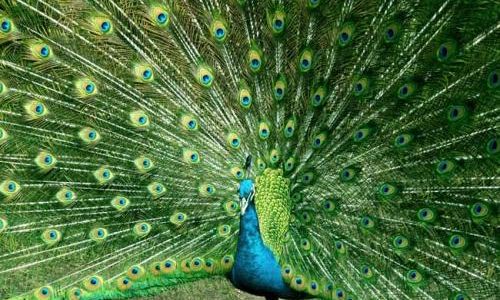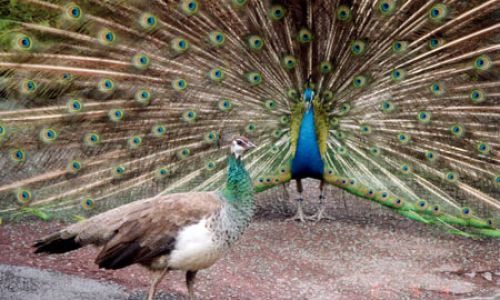The peacock’s iridescent, eye-spotted tail feathers have captivated human imagination for millennia, symbolizing beauty, pride, and vanity across cultures. Yet, beneath the allure of the male’s dramatic courtship display lies a lesser-known biological puzzle: do female peacocks—known as peahens—ever fan their own plumage in a similar fashion? This question challenges conventional wisdom about sexual dimorphism in birds and invites a deeper exploration of avian behavior, evolutionary biology, and the subtle complexities of animal communication.
Anatomy of Plumage: Male vs. Female Peafowl
To address this query, one must first dissect the anatomical differences between male and female peafowl. The Indian peafowl (Pavo cristatus), the species most familiar to humans, exhibits stark sexual dimorphism. Males possess a magnificent train of elongated upper tail coverts, or “tail feathers,” adorned with vibrant, metallic hues and distinctive ocelli (eyespots). These feathers, which can exceed six feet in length, are supported by specialized dorsal tail feathers and are used exclusively for courtship displays. Females, by contrast, have shorter, brownish-gray plumage with muted green and bronze accents, lacking the elongated train and ocelli. Their feathers are functional rather than ornamental, providing camouflage while foraging and nesting.
This dichotomy raises an immediate contradiction: if females lack the anatomical structures necessary for a full “train-rattling” display, how could they possibly replicate the male’s behavior? Yet, biology often defies simplicity. While peahens cannot unfurl a train of ocelli-studded feathers, they do possess a set of shorter upper tail coverts and dorsal feathers that, in theory, could be raised or fanned under specific circumstances. The question then shifts from can they display to do they display—and if so, why?
The Purpose of Male Displays: Courtship and Competition
To understand potential female displays, one must first grasp the evolutionary drivers behind male peacock behavior. The male’s extravagant plumage and elaborate strutting serve dual purposes: attracting mates and deterring rivals. During the breeding season, males gather in communal display arenas called leks, where they vocalize, shake their feathers, and fan their trains into a semicircular shape to impress females. The ocelli, when viewed from specific angles, create an optical illusion of motion and depth that scientists hypothesize may signal genetic fitness to peahens. Females, in turn, evaluate these displays, selecting mates based on feather quality, symmetry, and display vigor—traits linked to parasite resistance and overall health.
Male-male competition also shapes display dynamics. Dominant males with larger trains and more ocelli often intimidate subordinates, reducing physical confrontations. Thus, the male’s plumage is a multifunctional tool, balancing sexual signaling and social hierarchy maintenance.

Peahen Behavior: Beyond Passive Observation
Traditional narratives portray peahens as silent observers, methodically assessing male displays without engaging in comparable behaviors. However, emerging research challenges this passive role. Observations in both captive and wild populations reveal that females occasionally exhibit subtle feather movements, though these differ markedly from the male’s flamboyant routine.
-
Feather Ruffling and Posturing: During social interactions, peahens may raise their neck feathers, puff their bodies, or slightly spread their shorter upper tail coverts. These gestures, while less visually striking than male displays, could convey aggression, territoriality, or parental investment. For instance, a mother peahen guarding her chicks might adopt a stiff posture and partially fan her feathers to deter predators or rival females.
-
Vocalizations and Body Language: Though lacking a train, females use vocalizations (such as the shrill “kai-kai-kai” call) and body language to communicate. A peahen approaching a male’s lek may lower her head, spread her wings slightly, and emit soft clucks—a behavior some ornithologists interpret as a preliminary mating signal.
-
Mutual Display in Pair Bonding: In rare instances, paired peacocks and peahens engage in coordinated movements. A male might begin his display, and the female, positioned nearby, may flick her wings or raise her tail feathers in tandem. While speculative, this synchronized behavior could strengthen pair bonds or synchronize breeding timing.
Evolutionary Perspectives: Why Don’t Females Display More?
The absence of elaborate female displays in peafowl aligns with evolutionary theory. In species where males compete for female attention (a dynamic known as sexual selection), ornamental traits typically evolve in males, while females prioritize traits indicative of parental care or resource acquisition. Peahens, as the choosier sex, invest heavily in egg-laying and chick-rearing, leaving less energy for ornamental plumage.
However, this explanation raises further questions. Why, then, do some female birds in other species (e.g., phalaropes, jacanas) exhibit reverse sexual dimorphism, with females being more colorful? The answer lies in ecological and behavioral nuances. In species where females compete for mates or resources, sexual selection can favor female ornamentation. Peafowl, however, inhabit environments where male-male competition and female choice dominate, favoring the classic dimorphic model.
Hormonal and Genetic Influences
The hormonal underpinnings of plumage development offer additional insights. Male peacocks produce high levels of testosterone during the breeding season, which stimulates train growth and vibrant pigmentation. Females, by contrast, have lower testosterone levels, limiting feather elongation and coloration. Genetic factors further reinforce these differences: the androgen receptor gene and sonic hedgehog signaling pathway are implicated in train development, with females lacking the genetic switches to activate such traits.
Yet, exceptions exist. Rare instances of female peafowl with partial train elongation or atypical coloration have been documented, often linked to hormonal imbalances or genetic mutations. These aberrations, while fascinating, are non-representative of wild populations and do not indicate a latent capacity for widespread female display behavior.

Observational Studies: Captivity vs. the Wild
Captive environments, where peafowl are free from predators and resource limitations, sometimes elicit atypical behaviors. In zoos and sanctuaries, females may display more frequently, possibly due to reduced stress or artificial social structures. For example, a peahen confined with a single male might engage in prolonged wing-dragging or tail-spreading as part of courtship initiation. However, these behaviors remain sporadic and lack the ritualistic complexity of male displays.
In the wild, peahens prioritize stealth and energy efficiency. Their cryptic plumage aids in evading predators while incubating eggs or leading chicks through undergrowth. Engaging in conspicuous displays would compromise these survival strategies, suggesting that any female display behavior is context-dependent and evolutionarily constrained.
The Role of Anthropomorphism and Cultural Bias
Human perception also shapes interpretations of peafowl behavior. The male’s display has been romanticized in art, literature, and mythology, often overshadowing female behaviors. Early naturalists, focused on documenting male traits, may have overlooked subtle female signals. Modern ethology, armed with camera traps and behavioral tracking software, is beginning to rectify this bias, revealing the nuanced ways peahens communicate.
Conclusion: The Silent Majority
In summary, while peahens lack the anatomical and hormonal machinery to replicate the male’s legendary display, they are not entirely silent participants in peafowl social dynamics. Their behaviors—though understated—serve vital roles in communication, defense, and reproductive strategy. The female’s muted plumage and restrained demeanor reflect millions of years of evolutionary refinement, where subtlety often trumps spectacle.
The question “Can female peacocks display their feathers?” thus invites a nuanced answer: yes, but not in the way humans have historically defined “display.” Their feathers, though shorter and less vibrant, can be raised or fanned in specific contexts, signaling intent, establishing boundaries, or coordinating with mates. To perceive these actions as mere imitations of male behavior is to misunderstand the intricate language of avian communication.
As research methods advance, so too will our appreciation for the peahen’s role in this iconic species. Perhaps future studies will uncover even more layers to their behavior, reminding us that in nature, even the quietest voices hold stories worth hearing.






0 comments